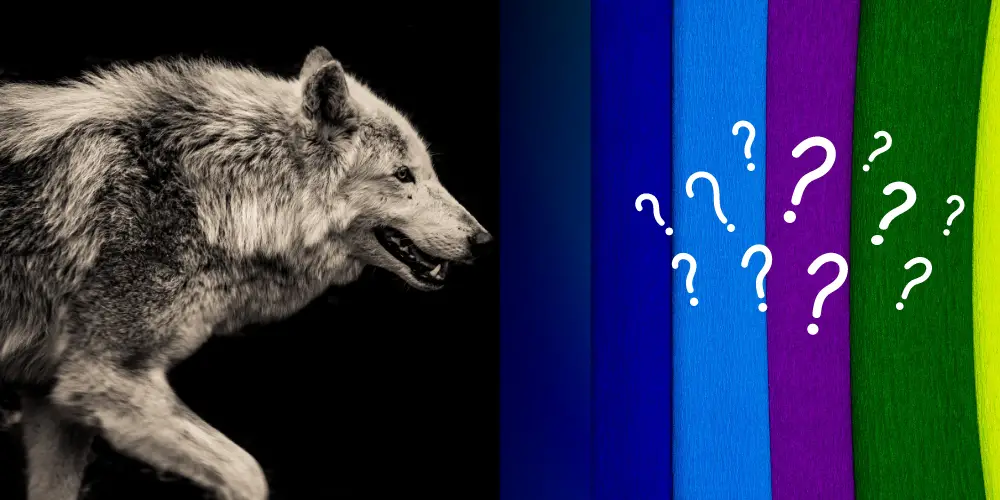From the frosty whites of the Arctic to the fiery reds of the South, the world of wolves is a kaleidoscope of colors.
Intrigued?
Join us as we journey into the wild, exploring the seven distinct shades of wolf colors that paint the tapestry of nature below:
- Gray
- White, Gray, Black & Brown Mix
- Red
- White
- Black
- Brown
- Yellow
Our journey will take us through the genetic factors that contribute to these colors and their significance to the survival and adaptability of wolves.
We will also address common myths surrounding wolf coat colors, how they have influenced art and design, and five ways wolf colors can benefit wolf preservation efforts.
Join us on this captivating journey as we dive into the colorful world of wolves!
Common Wolf Colors
1. Gray Wolf
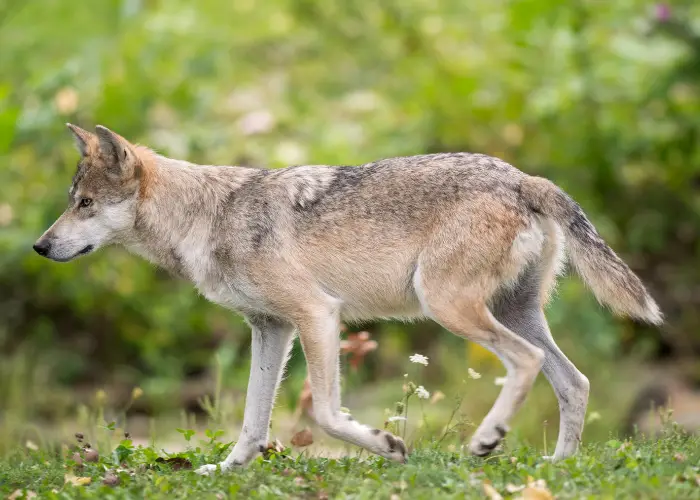
Color Variations
Despite their name, gray wolves display a stunning variety of fur colors. They can range from light gray to black, with some even sporting white or cream tones.
Geographic Distribution and Habitat
Gray wolves inhabit various habitats, from the Arctic tundra to dense forests and grasslands. They can be found across North America, Europe, and Asia, making them one of the most widespread large carnivores on the planet.
Subspecies and Distinct Colorations
There are several subspecies of gray wolves, each with unique color variations. For instance, the Mexican gray wolf has a predominantly gray and tan coat, while the Eurasian wolf features more of a reddish-brown hue.
Genetic Factors Influencing Gray Wolf’s Colors
The color of a gray wolf’s coat is determined by the interaction of several genes, including the MC1R gene, which influences melanin production.
Adaptation and Survival: The Role of Coat Color
The color of a Gray wolf’s coat is crucial to its survival. It provides camouflage in their specific habitats, enhancing their ability to hunt effectively and avoid predators.
2. White, Gray, Black, & Brown Mix
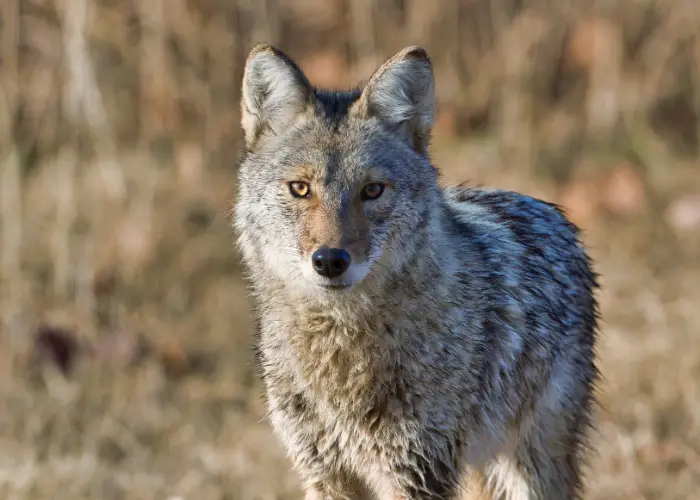
Description
Some wolves exhibit a mix of white, gray, black, and brown in their fur, creating a stunning and unique appearance. These mixed-color wolves are a testament to the incredible genetic diversity found within the species.
Genetic Factors Influencing Wolf Colors
The mixed fur coloration in wolves results from various genetic factors. These wolves may inherit a combination of genes from their parents, resulting in a unique coat color.
Adaptation and Survival: The Role of Coat Color
The mixed coloration may provide them with better camouflage in different environments or offer protection from harmful UV rays.
Geographic Distribution and Habitat of Mixed-Color Wolves
Mixed-color wolves are found in various habitats across North America, Europe, and Asia, often in regions with diverse vegetation and landscapes.
Rare Wolf Colors
3. Red Wolf
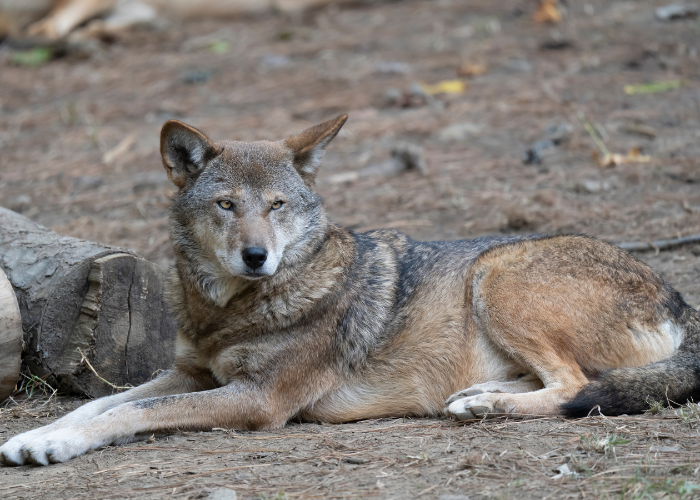
Description
The red wolf boasts a striking coat, ranging from tawny red to warm cinnamon hues, with touches of black along its back and tail. These fiery beauties are hard to miss when they roam the wilderness.
Geographic Distribution and Habitat
Once widespread throughout the southeastern United States, red wolves now primarily inhabit the eastern parts of North Carolina. They prefer a mix of forests, swamps, and coastal prairies as their habitat.
Genetic Factors Influencing Wolf Colors
Genetic factors influence the red wolf’s coat color. The reddish-brown coloration is thought to result from a mutation in the MC1R gene, which controls melanin production.
Adaptation and Survival: The Role of Coat Color
Their coat color helps them blend in with their habitat and prey, making them more effective hunters.
4. White Wolf

Description
Arctic wolves, also known as white wolves, are known for their pristine snow-white fur, which provides them with excellent camouflage in their icy habitat.
Genetic Factors Influencing Wolf Colors
The Arctic wolf’s white fur is an adaptation to its environment, allowing it to blend in with the snowy terrain. However, the genetic factors contributing to this white coat color are not fully understood.
Adaptation and Survival: The Role of Coat Color
The Arctic wolf has several adaptations to survive in its harsh environment. In addition to its white fur providing camouflage, its compact body helps it conserve heat, and its shorter legs make it easier to navigate the snowy terrain.
5. Black Wolf
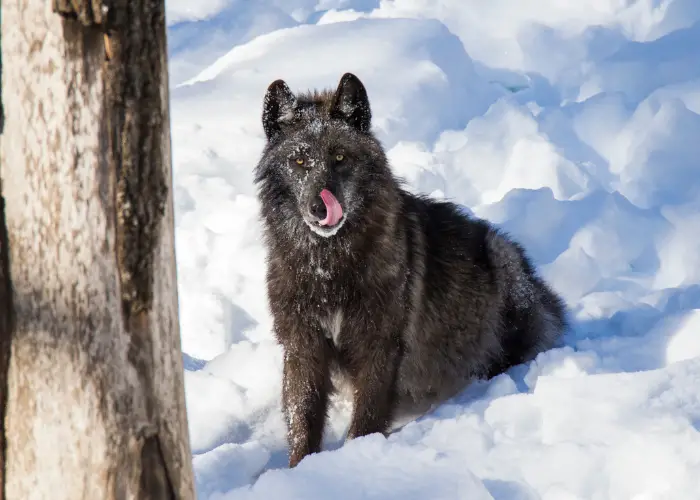
Description
The black wolf’s black coat ranges from a shiny jet-black to a dark charcoal gray. This uniform coloration is due to a genetic mutation that increases melanin production in their fur.
Genetic Factors Affecting Wolf Colors
The black coat color in wolves is primarily caused by a mutation in the K locus gene, which controls the distribution of melanin in the fur. This mutation results in an increased production of eumelanin, a pigment responsible for black and brown hues. Black wolves can be found in purebred wolf populations and hybrids with domestic dogs.
Geographic Distribution and Habitat
Black wolves have been observed in several regions worldwide, including North America, Europe, and Asia. They typically inhabit forests, mountains, and other wooded areas. Black wolves may have a selective advantage in these habitats, as their dark fur provides camouflage in areas with low light levels.
Adaptation and Survival: The Role of Coat Color
The black coat color in wolves is thought to have improved their hunting success.
Black wolves have a distinct advantage in hunting prey in low-light conditions, such as at dawn or dusk, as their dark fur provides excellent camouflage.
This adaptation allows them to move undetected by prey and hunt more effectively. The dark fur may also offer some protection from UV radiation, which harms the wolf’s skin.
6. Brown Wolf
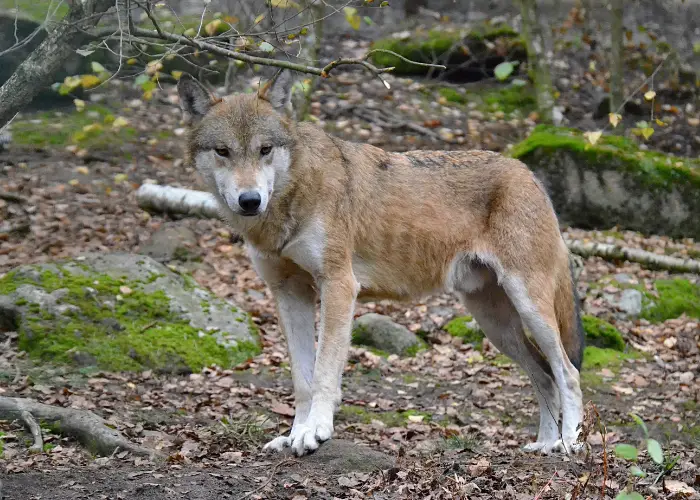
Description
Brown wolves typically have fur that ranges from light brown to dark brown and may have a mix of different hues. Their coats may also feature white or gray patches, giving them a unique appearance.
Relationship to Gray Wolf Species
Brown wolves are a color variant of the gray wolf species. Like the black wolf, brown coloration results from genetic mutations that affect the distribution of melanin in their fur.
Geographic Distribution and Habitat
Brown wolves can be found in various North American, Europe, and Asia habitats. They often inhabit regions with dense vegetation, where their coat color provides excellent camouflage.
Genetic Factors Influencing Wolf Colors
Genetic factors influence the brown coat color in wolves. The color variation is thought to result from a mutation in the MC1R gene, which controls melanin production.
Adaptation and Survival: The Role of Coat Color
Brown wolves’ coat color helps them blend in with their habitat and prey, making them more effective hunters.
Rarest Wolf Colors
7. Yellowish-Tinted Wolf

Description
Yellowish-tinted wolves have a unique coat with a golden or yellow hue, often combined with gray or white markings. This coloration is relatively rare among wolves and adds to the diversity of their appearance.
Genetic Factors and Relationship to Gray Wolf Species
Like brown wolves, yellowish-tinted wolves are a color variant of the gray wolf species. Their distinctive fur color results from specific gene combinations that influence pigmentation.
Geographic Distribution and Habitat
Yellowish-tinted wolves are typically found in the same habitats as other gray wolf populations across North America, Europe, and Asia. Their distribution, however, is not well-documented due to their rarity.
Genetic Factors Influencing Wolf Colors
The yellowish-tinted fur in wolves is thought to result from genetic mutations that impact pigmentation. These mutations may occur in the MC1R or ASIP genes, which regulate melanin production and distribution.
Adaptation and Survival: The Role of Coat Color
Sometimes, yellowish-tinted fur may provide better camouflage in specific environments, such as areas with tall grasses or light-colored rocks.
Importance of Wolf Coat Colors in Behavior and Ecology
Mate selection
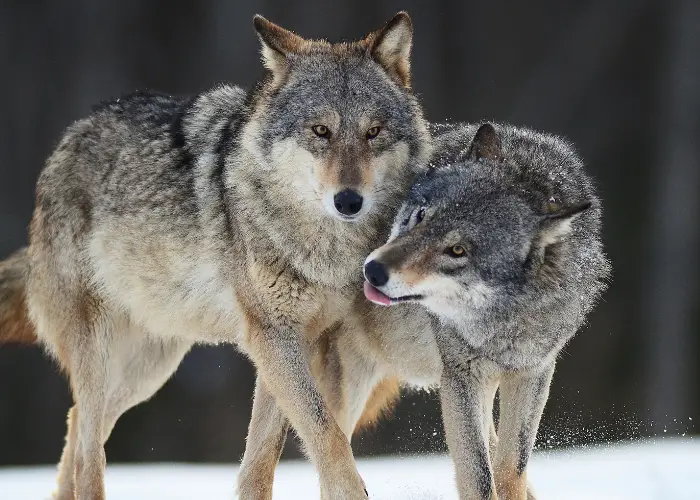
Wolf coat colors can play a role in mate selection. Wolves often use visual cues like coat color to identify potential mates.
In some cases, wolves may prefer mates with similar coat colors, which could help to maintain certain color variations within a population.
Alternatively, wolves may select mates with different coat colors, which could result in hybridization and new color variants.
Social Dynamics Within Wolf Packs
Coat color can also impact social dynamics within wolf packs. Dominance hierarchies are often established within packs, and coat color may play a role in determining social status.
For example, in some wolf packs, individuals with darker coats may be more dominant than those with lighter coats. This could be due to the perceived advantage of darker colors for camouflage or other adaptive benefits.
Ecological Significance
Wolf coat colors can also have ecological significance, impacting the interactions between wolves and their environment.
For example, white or light-colored wolves may have an advantage over darker-colored individuals in areas with heavy snowfall due to their increased camouflage in snowy environments.
In areas with dense forest cover, wolves with brown or gray coats may be better camouflaged and therefore, more successful at hunting.
Understanding these ecological relationships can provide insight into how wolf populations are adapted to their environments and may inform conservation efforts.
Overall Health
Wolves with black coats showed better survival rates when faced with canine distemper than gray-coated wolves. Additionally, these black-coated wolves exhibited high levels of reproductive success and other important vital rates.
How Wolf Colors Influenced Art and Design:
Historical Examples:
- Cave Paintings: Ancient cave paintings often depict wolves in various colors, showcasing their significance in prehistoric cultures. For example, the Chauvet Cave in France has over 30,000-year-old paintings that include wolves with varying coat colors, reflecting their importance in the lives of early humans.
- Native American Art: Native American tribes revered wolves and often included them in their artwork and cultural symbols. The various coat colors of wolves were used to represent different spiritual aspects or attributes of the animal, such as strength, courage, and wisdom.
- European Folklore and Art: In European folklore and art, wolves have been depicted in various colors, often symbolizing different qualities or characteristics. For example, in the Little Red Riding Hood tale, the wolf is often portrayed as dark or black, signifying danger and cunning.
Modern Examples
- Fashion: Designers in the fashion industry have been inspired by wolf colors, using their natural hues to create unique and eye-catching clothing items. For instance, some designers may use faux fur in shades of gray, white, or black to create coats, vests, or accessories that evoke the beauty of wolves and their coats.
- Interior Design: The natural colors of wolves have also found their way into interior design. Gray and earthy brown tones often create a warm, cozy, and rustic atmosphere in homes and commercial spaces, drawing inspiration from the wolves’ natural habitats.
- Wildlife Photography and Art: Modern-day artists and photographers often capture the stunning beauty of wolves and their diverse coat colors, showcasing their images in galleries, exhibitions, or as prints for home decoration. These photographs and artworks celebrate the uniqueness of each wolf’s coat color and help raise awareness about the importance of conservation efforts.
- Film and Animation: Wolf colors have inspired character designs in films and animated movies. For example, the wolves in the animated movie “Alpha and Omega” come in various colors, representing their distinct personalities and roles in the story. This film showcases the beauty and diversity of wolf coat colors while entertaining viewers with a heartwarming tale.
Common Myths About Wolf Coat Colors
Myth #1: Wolves with black fur are more aggressive and dangerous.
Scientific evidence: No scientific evidence supports the claim that black wolves are more aggressive or dangerous than wolves with other coat colors. Various factors, such as environmental conditions, pack dynamics, and individual personalities determine aggression and behavior.
Myth # 2: Gray wolves with white fur are a separate subspecies.
Scientific evidence: The white fur of gray wolves is a genetic variation that can occur in any subspecies of gray wolf. It is not indicative of a separate subspecies.
Myth # 3: White wolves are a separate species.
Scientific evidence: White wolves, also known as Arctic wolves, are not a separate species. They are a subspecies of gray wolves adapted to living in the Arctic tundra.
Myth #4: The coat color of wolves can change with the seasons.
Scientific evidence: The coat color of wolves does not change with the seasons. However, some individual wolves may appear to have lighter or darker fur during different times of the year due to variations in fur density or exposure to sunlight.
Myth #5: All wolves of the same subspecies have identical coat colors.
Scientific evidence: Wolves of the same subspecies can have a range of coat colors and patterns depending on genetics and environmental factors. For example, gray wolves in North America can range from light gray to black, with some sporting white or cream tones.
5 Ways Wolf Colors Benefit Preservation
- Population monitoring and tracking: Researchers can more accurately monitor and track specific packs or individuals by studying the variations in coat colors among wolf populations. This information can help identify migration patterns, assess the health of populations, and detect potential threats such as habitat loss or human-wildlife conflicts.
- Genetic diversity assessment: The diversity of coat colors within a wolf population can provide valuable insights into the genetic health and diversity of the population. A more diverse gene pool is crucial for a species’ ability to adapt to environmental changes and resist diseases. Conservationists can use this information to develop targeted strategies for preserving genetic diversity and ensuring the long-term survival of wolf populations.
- Habitat management and preservation: The various coat colors of wolves are often adaptations to their specific habitats, providing camouflage and other benefits for survival. Understanding the relationship between coat colors and habitat can help conservationists identify critical areas that need protection to preserve these adaptations and ensure the survival of wolf populations. This information can guide decisions on land-use planning, habitat restoration, and the establishment of protected areas.
- Public awareness and education: A better understanding of the diversity and significance of wolf coat colors can be used to raise public awareness about wolf conservation. By showcasing wolves’ unique beauty and adaptability through their coat colors, conservation organizations can inspire people to support and engage in conservation efforts. Educational programs and materials highlighting the importance of coat colors in wolf ecology can help foster a deeper appreciation for these animals and their role in the ecosystem.
- Species identification and hybridization studies: Understanding wolf coat colors can help distinguish between different subspecies, identify hybrids with domestic dogs, and assess the potential impacts of hybridization on wild wolf populations. This information is essential for designing appropriate conservation and management strategies to maintain the genetic integrity of wild wolf populations.
Conclusion
The world of wolf coat colors is truly fascinating, from fiery reds to icy whites. These diverse hues add to these magnificent creatures’ beauty and play a vital role in their survival and adaptation to different environments.
Each color variation provides unique advantages to the wolves, be it through camouflage, insulation, or other adaptations that enhance their ability to thrive in their specific habitats.
As we marvel at the incredible range of wolf coat colors, it’s crucial to remember the importance of conservation efforts. By protecting and preserving these remarkable animals, we can ensure that future generations have the opportunity to appreciate and learn from the diverse world of wolves.
REFERENCES:
1.Gipson, P. S., Bangs, E. E., Bailey, T. N., Boyd, D. K., Cluff, H. D., Smith, D. W., & Jiminez, M. D. (2002). Color Patterns among Wolves in Western North America. Wildlife Society Bulletin (1973-2006), 30(3), 821-830. https://doi.org/10.2307/3784236
2. Cubaynes, S., Brandell, E. E., Stahler, D. R., Smith, D. W., Almberg, E. S., Schindler, S., Wayne, R. K., Dobson, A. P., MacNulty, D. R., Cross, P. C., Hudson, P. J., & Coulson, T. (2022). Disease outbreaks select for mate choice and coat color in wolves. Science. https://doi.org/abi8745

